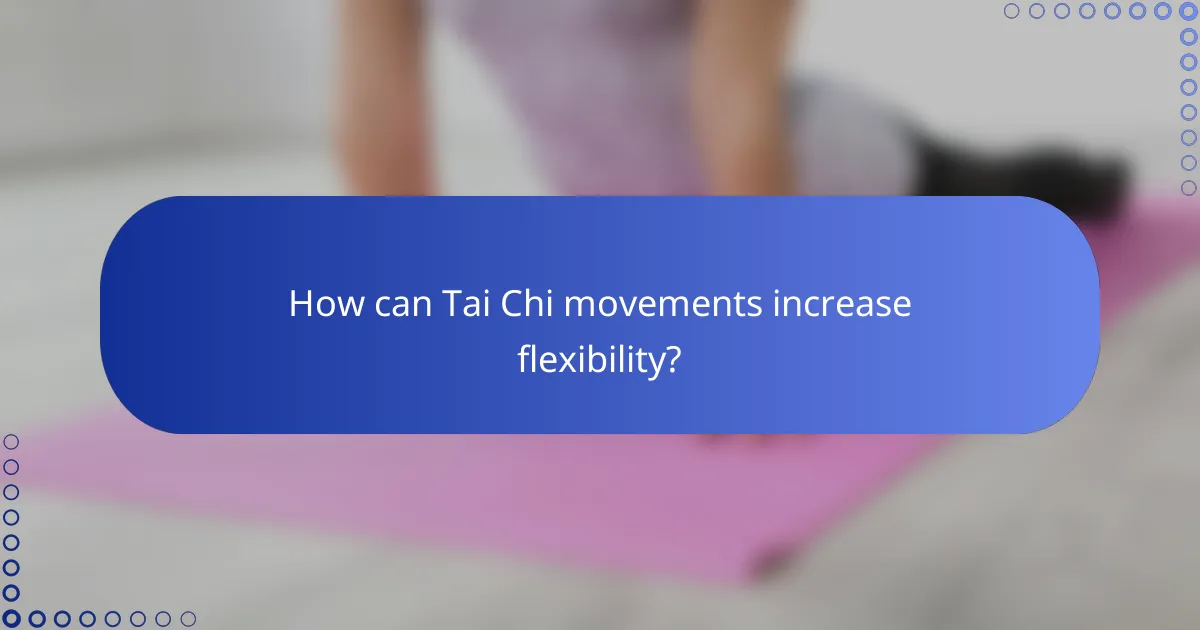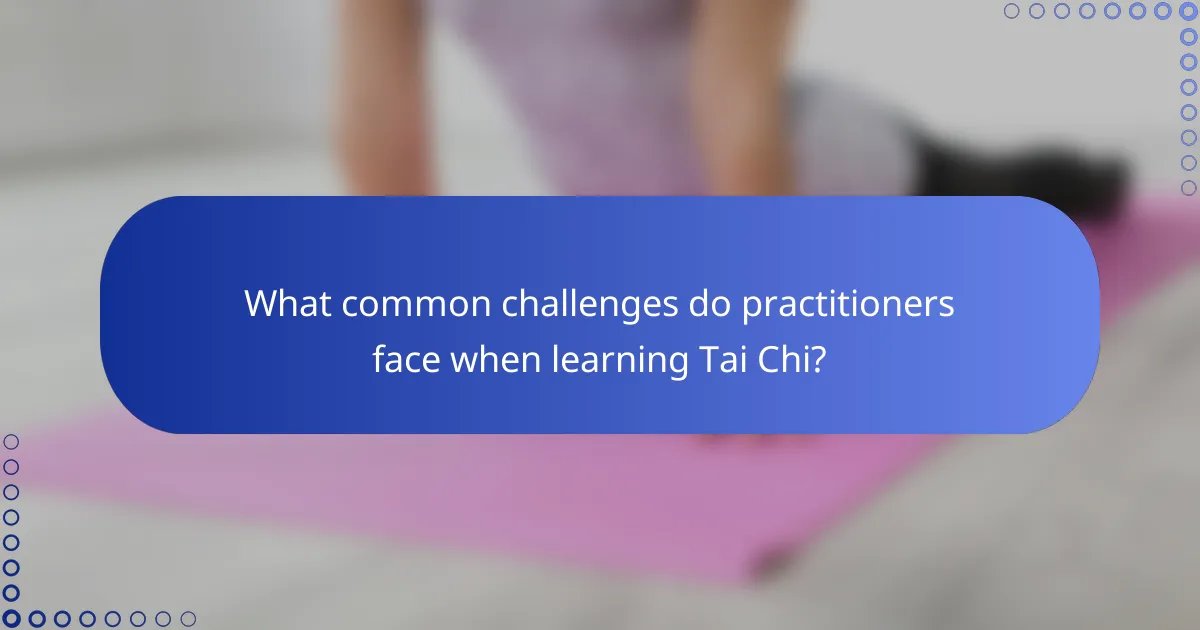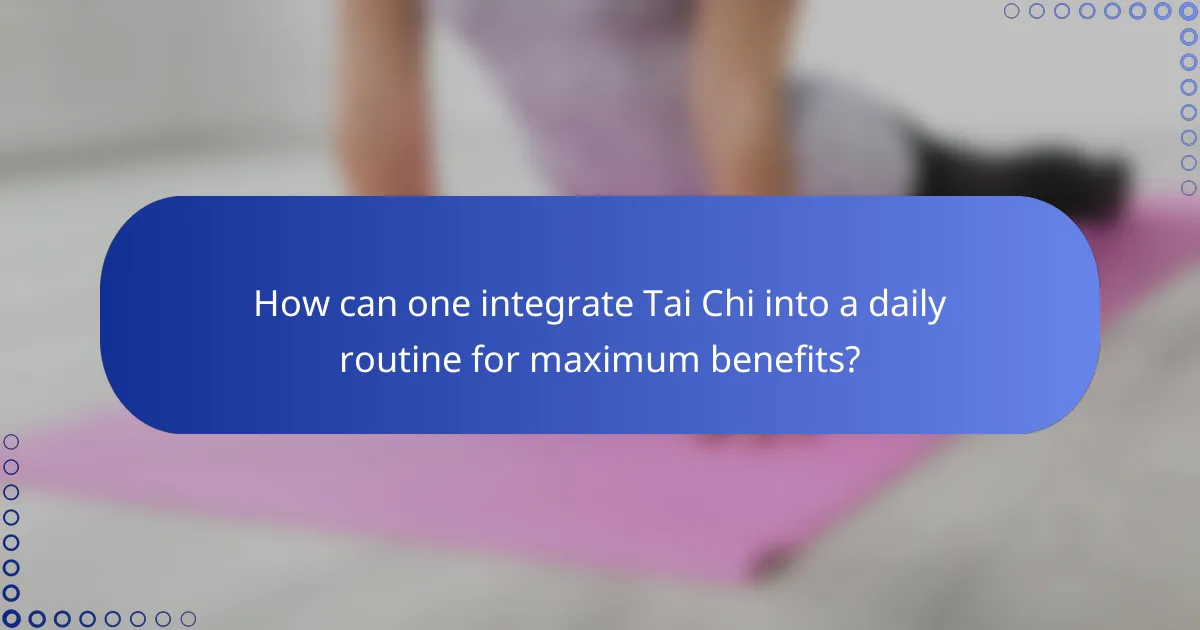Tai Chi movements enhance balance, flexibility, and mindfulness, making them beneficial for various practitioners. These slow, controlled motions improve core strength and proprioception, leading to better coordination. Additionally, Tai Chi fosters mental focus and relaxation, promoting overall well-being. Regular practice can significantly reduce fall risk, especially for older adults and those recovering from injuries.

How do Tai Chi movements enhance balance and stability?
Tai Chi movements significantly enhance balance and stability through slow, controlled motions. These movements engage core muscles, improve proprioception, and promote body awareness. As a result, practitioners experience better coordination and reduced risk of falls. Research indicates that regular practice can lead to a 25% improvement in balance-related metrics. Additionally, Tai Chi fosters mindfulness, helping individuals focus on their movements, which further enhances stability.
What specific Tai Chi forms are best for improving balance?
The best Tai Chi forms for improving balance include the “Grasp the Bird’s Tail,” “Wave Hands Like Clouds,” and “Single Whip.” These movements enhance stability and coordination. “Grasp the Bird’s Tail” focuses on weight shifting, while “Wave Hands Like Clouds” promotes fluidity and control. “Single Whip” emphasizes posture and alignment, crucial for balance. Regular practice of these forms can lead to significant improvements in balance and overall body awareness.
How does practicing Tai Chi influence proprioception?
Practicing Tai Chi significantly enhances proprioception by improving body awareness and balance. The slow, deliberate movements require concentration and mindfulness, fostering a deeper connection between the mind and body. This increased awareness helps individuals better perceive their body’s position in space, which is essential for maintaining balance. Additionally, Tai Chi movements engage various muscle groups, further contributing to stability and coordination. Through consistent practice, participants often report enhanced proprioceptive abilities, leading to improved overall physical performance and reduced risk of falls.
What role does body alignment play in Tai Chi for balance?
Body alignment is crucial in Tai Chi for enhancing balance. Proper alignment allows practitioners to distribute weight evenly and maintain stability during movements. This alignment supports the body’s natural structure, reducing the risk of injury and increasing the efficacy of each posture.
When the body is aligned, energy flows more freely, promoting mindfulness and enhancing the benefits of Tai Chi. Studies show that individuals practicing Tai Chi with a focus on alignment experience improved balance and coordination.
Moreover, correct alignment helps in developing core strength, which is essential for maintaining stability. As a result, practitioners can perform movements with greater ease and control, ultimately leading to better overall physical health.

How can Tai Chi movements increase flexibility?
Tai Chi movements can significantly enhance flexibility through their slow, controlled motions. These movements stretch and strengthen muscles, improving the range of motion in joints. As a result, practitioners often experience increased overall flexibility. Regular practice of Tai Chi can lead to better posture and alignment, further contributing to enhanced flexibility. This gentle form of exercise promotes relaxation, allowing muscles to lengthen and become more pliable.
Which Tai Chi techniques effectively promote flexibility in joints?
Tai Chi techniques that effectively promote flexibility in joints include the “Wave Hands Like Clouds” and “Grasp the Bird’s Tail.” These movements enhance joint mobility through gentle, flowing motions. They encourage a full range of motion while promoting relaxation and mindfulness. Practicing these techniques regularly can lead to improved flexibility and reduced stiffness in joints.
How does the slow, controlled motion of Tai Chi aid in stretching?
The slow, controlled motion of Tai Chi enhances stretching by promoting flexibility and relaxation. This practice encourages deep breathing, which helps release tension in muscles. The gradual movements allow for a full range of motion, improving joint health and reducing stiffness. Additionally, Tai Chi cultivates mindfulness, enabling individuals to focus on body alignment and posture, further enhancing the effectiveness of each stretch. This unique combination of movement and mental focus makes Tai Chi an effective method for improving overall flexibility and balance.
What are the differences in flexibility benefits between Tai Chi styles?
Different Tai Chi styles offer varying flexibility benefits due to their unique movements and approaches. Yang style emphasizes long, flowing movements, enhancing overall flexibility. Chen style incorporates explosive movements and deeper stances, which can improve flexibility in specific muscle groups. Wu style focuses on smaller, more compact movements, promoting joint flexibility. Sun style combines elements of other styles, offering a balanced approach to flexibility. Each style’s methodology influences how practitioners experience and achieve flexibility benefits.

Why is mindfulness an integral part of Tai Chi practice?
Mindfulness is essential in Tai Chi practice as it enhances focus and body awareness. This mental state improves balance and flexibility by promoting a deeper connection with movements. Mindfulness reduces stress, allowing practitioners to engage fully with each posture. As a result, the integration of mindfulness fosters a holistic approach, benefiting both mental and physical health in Tai Chi.
How does mindfulness in Tai Chi contribute to mental health?
Mindfulness in Tai Chi enhances mental health by reducing stress and improving emotional regulation. The slow, deliberate movements promote relaxation, helping to alleviate anxiety and depression. Research shows that regular practice can lead to significant improvements in overall mental well-being. Engaging in Tai Chi fosters a sense of presence, allowing practitioners to develop greater self-awareness and emotional resilience.
What meditation techniques are incorporated into Tai Chi movements?
Tai Chi incorporates meditation techniques such as focused breathing, visualization, and mindful awareness. These elements enhance balance, flexibility, and mindfulness during practice. Focused breathing regulates energy flow, while visualization aids in achieving mental clarity. Mindful awareness cultivates presence, allowing practitioners to connect deeply with movements.
How can mindfulness during Tai Chi improve focus and concentration?
Mindfulness during Tai Chi significantly enhances focus and concentration. This practice encourages deep breathing and present-moment awareness, allowing practitioners to connect mind and body.
Engaging in Tai Chi movements requires attention to detail, which fosters mental clarity. As a result, individuals experience improved cognitive function and reduced distractions. Mindfulness also promotes relaxation, further enhancing concentration levels.
Regular practice of mindful Tai Chi can lead to long-term benefits, including increased mental resilience and better stress management. Overall, integrating mindfulness into Tai Chi not only improves physical balance and flexibility but also sharpens mental focus.

Which demographic groups benefit most from Tai Chi movements?
Older adults, individuals with chronic pain, and those recovering from injuries benefit most from Tai Chi movements. These groups experience improved balance, flexibility, and mindfulness through gentle, flowing exercises. Research indicates that Tai Chi reduces fall risk by enhancing stability, particularly in older adults. Additionally, it helps manage pain and enhances recovery for those with injuries.
How do Tai Chi movements cater to seniors’ health needs?
Tai Chi movements effectively enhance seniors’ health by improving balance, flexibility, and mindfulness. These gentle exercises reduce the risk of falls, increase joint mobility, and promote mental well-being. Regular practice can lead to better posture and coordination, addressing common concerns among older adults. Additionally, Tai Chi fosters social interaction, which is vital for emotional health.
What are the benefits of Tai Chi for athletes and active individuals?
Tai Chi offers numerous benefits for athletes and active individuals, enhancing balance, flexibility, and mindfulness. These movements improve coordination and body awareness, which are crucial for performance in various sports.
Regular practice of Tai Chi can increase flexibility, reducing the risk of injuries during physical activities. It also promotes mental clarity and focus, aiding in stress reduction and improving overall athletic performance. Additionally, Tai Chi emphasizes controlled breathing, which enhances lung capacity and endurance.
Incorporating Tai Chi into training routines can lead to better recovery times and improved muscle relaxation. This holistic approach not only benefits physical health but also contributes to mental well-being, making it an ideal practice for athletes and active individuals alike.

What common challenges do practitioners face when learning Tai Chi?
Practitioners often face challenges in mastering Tai Chi due to its complex movements and the need for mental focus. Common difficulties include maintaining balance during transitions, achieving fluidity in movements, and integrating mindfulness with physical practice. Additionally, some may struggle with the slow pace, which requires patience and consistent practice. Physical limitations or prior injuries can also hinder progress, making it essential for practitioners to adapt movements to their capabilities.
How can beginners overcome difficulties in mastering Tai Chi forms?
Beginners can overcome difficulties in mastering Tai Chi forms by practicing regularly, focusing on breath control, and seeking guidance from experienced instructors. Consistent practice enhances muscle memory and promotes balance. Breath control aids in mindfulness, allowing practitioners to connect movements with mental focus. Additionally, personalized feedback from instructors can address specific challenges and improve performance.
What are the misconceptions about Tai Chi that hinder practice?
Misconceptions about Tai Chi include the belief that it is solely for elderly individuals, lacks physical intensity, and is merely a meditative practice. These misunderstandings can discourage broader participation.
Many think Tai Chi is too gentle to improve fitness, but it enhances balance, flexibility, and strength. Others believe it is only for older adults, ignoring its benefits for all ages. Additionally, some view it as just meditation, overlooking the physical movements that promote overall wellness.
Correcting these misconceptions can encourage more people to experience the comprehensive benefits of Tai Chi, which include improved mental focus and physical health.

How can one integrate Tai Chi into a daily routine for maximum benefits?
To integrate Tai Chi into a daily routine for maximum benefits, practice consistently, ideally for 20-30 minutes each day. Begin with basic movements, focusing on balance, flexibility, and mindfulness.
1. Set a specific time each day for practice, such as morning or evening.
2. Choose a quiet space free from distractions.
3. Start with warm-up exercises to prepare your body.
4. Gradually incorporate different Tai Chi forms to enhance variety and engagement.
5. Focus on your breathing and mental state during practice to promote mindfulness.
6. Consider joining a local class or online session for guidance and community support.
Regular practice can improve physical health and mental clarity over time.
What are the recommended durations and frequencies for Tai Chi practice?
For effective Tai Chi practice, aim for 20 to 60 minutes per session, three to five times a week. Regular practice enhances balance, flexibility, and mindfulness. Consistency is key for optimal benefits.
How can technology enhance the learning of Tai Chi movements?
Technology can enhance the learning of Tai Chi movements by providing interactive tools and resources. Apps and wearable devices can track progress and offer real-time feedback on posture and balance. Virtual reality can create immersive environments for practice, improving focus and engagement. Online tutorials and video demonstrations allow learners to visualize movements clearly, aiding retention. Additionally, community platforms foster connection and support among practitioners, enhancing motivation and commitment.
What expert tips can improve your Tai Chi practice effectively?
To improve your Tai Chi practice effectively, focus on consistency, proper posture, and mindful breathing. Regular practice enhances balance, flexibility, and mindfulness.
Incorporate these expert tips:
1. **Establish a Routine**: Practice at the same time daily to build habit.
2. **Focus on Posture**: Maintain alignment to optimize movement flow.
3. **Mindful Breathing**: Synchronize breath with movements for enhanced focus.
4. **Use Visualizations**: Imagine energy flowing through your body to deepen awareness.
5. **Seek Feedback**: Work with a qualified instructor for personalized guidance.
These strategies will enhance the overall effectiveness of your Tai Chi practice.